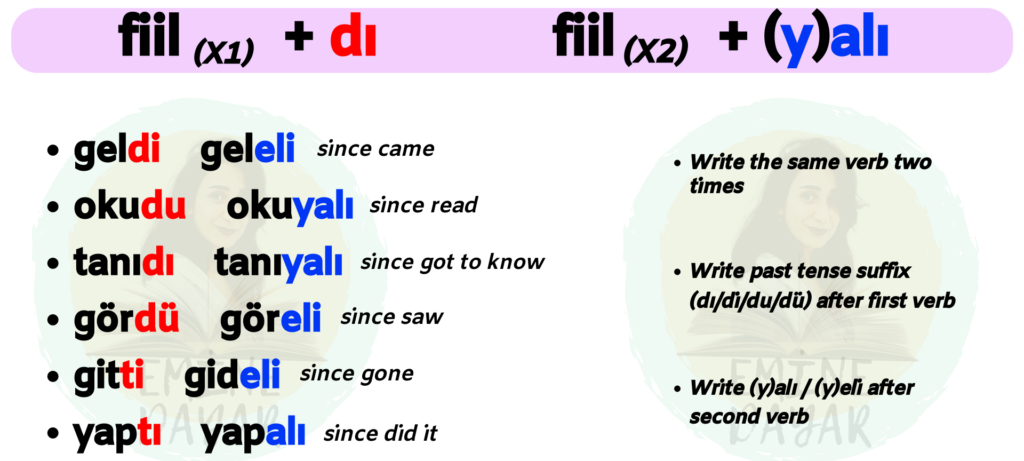What is -eli/-alı/-yeli/-yalı in Turkish? And Why is It Used?
It is used in a similar sense to the structure (-diğinden/since) that I explained in the previous lesson. -eli/ -alı / -yeli / -yalı suffixes are indicates when the verb begins. We understand that the verb is the starting point and still continuing. Just like “for” in English. (I am waiting for you for two years.)
Difference Between -diğinden beri ve -alı/-eli
There is not much difference between them. You can generally use the two interchangeably. But I can talk about the difference in meaning. In the structure “-diğinden beri”; the event started somewhere and still continues, but you especially emphasize the starting point of the event. “-ali, -eli” the event started somewhere and still continues, but you especially emphasize the whole process of the event. It is used in the same sense as -dir you learned in Turkish A1.
Difference Between -alı/-eli -diğinden beri -den beri -dir
1.-diğinden beri; It emphasizes the starting point. It is used with verbs.
2. -den beri; It emphasizes the starting point. It is used with nouns.
3. -eli / -alı; It emphasizes the whole process. Used with verbs.
4. -dir; It emphasizes the whole process. Used with nouns.
Example Sentences With -eli / -alı
Dolar artalı her şeye zam geliyor.
- Since the dollar has increased, everything is going up.
Türkiye’ye geleli 1 hafta oldu.
- It’s been a week since I came to Turkey.
Seni görmeyeli uzun zaman oldu.
- Long time no see.
Kitap okumayalı 2 ay oldu.
- It’s been 2 months since I read the book.
Kursa gideli daha iyi Türkçe konuşuyorum.
- I speak better Turkish since I went to the course.
Rules
1. The first is checking the vowel harmony like everytime. But this time it’ll be 2 way vowel harmony. Cause just there are -eli and -alı forms. If the last vowel of the verb is “a, ı, o or u” the suffix should be -alı. And if the last vowel of the verb is “e, i, ö or ü” the suffix should be -eli.
2. Don’t forget to use “y” between suffix and verbs end vith any vowel. Remember two vowels can not be side by side. So we use “y” between them.
 tanış+alı
tanış+alı- gel+eli
- uyu+yalı
- gizle+yeli
3. To use with negative verbs again just use -me or -ma right after verb just like i said above for -dığından beri. Attention again -me/-ma negative suffixes are ends with vowel. Hmmm… You have to write -eli/-alı after it. But you can’t start with a vowel. Soo let’s put a “y” again between vowels!

4. You can also use this structure in accordance with the formula in the image below. (Differently, the verb is said 2 times and the past tense is used in the first verb.) This verb is said to make it more emphatic and effective. But bear in mind! We generally use it in negative situations, that is, when something we don’t like happens!

Dolar arttı artalı her şeye zam geliyor. (Zam olumsuz bir şey)
- Since the dollar has increased, everything is going up. (Raise is a negative thing)
Üniversiteye başladım başlayalı tüm param bitti. (Paranın bitmesi olumsuz bir şey)
- Since I started college, all my money is gone. (Out of money is a negative thing)
Bu dizi çıktı çıkalı kızımızın yüzünü göremiyoruz, sürekli dizi izliyor. (Kızımızı görememiz l-olumsuz bir şey)
- We can’t see our daughter’s face since this series came out, she watches TV series all the time. (It’s a negative thing that we can’t see our daughter)
PAY ATTENTION!
But beware, if there is a negative suffix “-me, -ma” in the verb, we cannot say the verb twice!
Onunla görüşmedim görüşmeyeli 3 yıl oldu. (THAT’S WRONG)
Onunla görüşmeyeli 3 yıl oldu. (THAT’S RIGHT)
- It’s been 3 years since I met her/him.
If you have any question about -den beri, -diğinden beri, -eli/alı / since, for in Turkish or any subject about Turkish language just let me know in the comment below. Btw we also share all Turkish grammar lessons, some daily usefull tips, Turkish idioms and more about Turkish language and Turkish culture on YouTube channel! You can watch all lessons for free now! and Just click here subscribe to don’t lose our videos. See you in another lesson!
